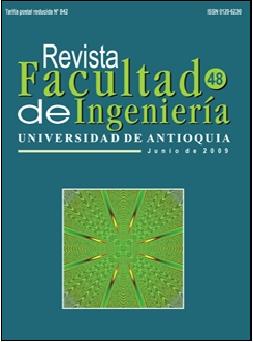Numerical solution of biological reaction diffusion models on fixed domains by the finite element method
DOI:
https://doi.org/10.17533/udea.redin.16020Keywords:
Reaction diffusion models, pattern formation, finite element method, biomathematicsAbstract
Several biological phenomena have been described using mathematical models based on reaction diffusion equations. The solution of this type of equations gives rise to formation of spatial-temporal patterns, in agreement with the biological reality of the simulated phenomenon. This article describes the numerical implementation of a set of three well-known reaction diffusion models: the morphogenesis Schnakenberg model, and the GiererMeinhardt and Thomas reaction kinetics models. The aim is to analyze the set of parameters associated with the spatial-temporal pattern formation. The numerical implementation was performed using the finite element method in one dimensional and two dimensional domains. It was concluded that spatialtemporal pattern formation in reaction diffusion models depends on the constant parameters of the model, the initial conditions and the implementation technique. The analysis of these dependences is useful in the formulation and validation of new mathematical models describing biological phenomena.
Downloads
References
P. K. Maini. “Mathematical models in morphogenesis”. Mathematics Inspired by Biology. Ed. Springer Berlin- Heidelberg. 1999. pp. 151-189. DOI: https://doi.org/10.1007/BFb0092377
D. A. Garzón. Simulación de procesos de reacción difusión: aplicación a la morfogénesis del tejido óseo. Tesis de Doctorado. Zaragoza. España: Centro Politécnico Superior de la Universidad de Zaragoza. 2007. pp. 38-70.
D. Benson, P. Maini, J. A. Sherratt. “Unravelling the Turing bifurcation using spatially varying diffusion coefficient”. J. Math. Biol. Vol. 37. 1998. pp. 381- 417. DOI: https://doi.org/10.1007/s002850050135
P. K. Maini, K. Painter, H. Chau. “Spatial pattern formation in chemical and biological systems”. J. Chem. Soc. Faraday Trans. Vol. 93. 1997. pp. 3601- 3610. DOI: https://doi.org/10.1039/a702602a
A. Turing. “The chemical basis of morphogenesis”. Philos. Trans. Roy. Soc. Vol. 237. 1952. pp. 37-72. DOI: https://doi.org/10.1098/rstb.1952.0012
M. Dolnik, A. M. Zhabotinsky, A. B. Rovinsky, I. R. Epstein. “Spatio-temporal patterns in a reaction diffusion system with wave instability”. Chemical Engineering Science. Vol. 55. 2000. pp. 223-231. DOI: https://doi.org/10.1016/S0009-2509(99)00318-8
J. D. Murray. Mathematical Biology II. Spatial models and biomedical applications. 3a. ed. Ed. Springer-Verlag. New York. 2003. pp. 75-97.
K. Page, P. K. Maini, N. Monk. “Patter formation in spatially heterogeneous Turing reaction diffusion models”. Physics D. Vol. 181. 2003. pp. 80-101 DOI: https://doi.org/10.1016/S0167-2789(03)00068-X
A. Madzvamuse, A. J. Wathen, P. K. Maini. “A moving grid finite element method applied to a model biological patter generador”. Journal of Computational Physics. Vol. 190. 2003. pp. 478-500. DOI: https://doi.org/10.1016/S0021-9991(03)00294-8
T. Miura, K. Shiota. “TGFβ-2 acts as an activator molecule in reaction-diffusion model and is involved in cell sorting phenomenon in mouse limb micromass culture”. Dev. Dyn. Vol. 217. 2000. pp. 241-249. DOI: https://doi.org/10.1002/(SICI)1097-0177(200003)217:3<241::AID-DVDY2>3.0.CO;2-K
S. Kondo, R. Asai. “A reaction diffusion wave on the skin of the marine angelfish Pomacanthus”. Nature. Vol. 376. 1995. pp. 765-768. DOI: https://doi.org/10.1038/376765a0
H. Jung, P. Francis-West, R. Widelitz, T. Jiang, S. Ting- Berreth, C. Tickle, L. Wolpert, C. Chuong. “Local inhibitory action of BMPs and their relationships with activators in feather formation: implications for periodic patterning”. Dev. Biol. Vol. 196. 1998. pp. 11-23. DOI: https://doi.org/10.1006/dbio.1998.8850
T. Miura, K. Morriss, P. K. Maini. “Mixed-mode pattern in doublefoot mutant mouse limb: Turing reaction diffusion model on a growing domain during limb development”. J. Theor Biol. Vol. 240. 2006. pp. 562-573. DOI: https://doi.org/10.1016/j.jtbi.2005.10.016
J. D. Murray. Mathematical Biology I. An introduction.3a ed. Ed. Springer-Verlag. New York. 2002. pp. 405-509.
K. Painter. Chemotaxis as a mechanism for morphogenesis. PhD Thesis. United Kingdom. Oxford University. 1997. pp. 3-25.
J. C. Vanegas A., N. S. Landinez, D. A. Garzón-Alvarado. “Análisis de la inestabilidad de Turing en modelos biológicos”. Revista DYNA, Universidad Nacional de Colombia - Medellín. Aprobado para publicación. 2009.
J. D. Murray, G. F. Ester. “Cell traction models for generation pattern and form in morphogenesis”. J. Math. Biology. Vol. 19. 1984. pp. 265-279. DOI: https://doi.org/10.1007/BF00277099
A. Madzvamuse. A numerical approach to the study of spatial pattern formation. PhD Thesis. Oxford, UK: Computing Laboratory. University of Oxford. 2000. pp. 10-40.
E. Crampin. Reaction diffusion patterns on growing domains. PhD Thesis. Oxford, UK: Magdalen College. University of Oxford. 2000. pp.1-34.
E. Oñate, J. Miquel, F. Zárate. “Stabilized solution of the multidimensional advection–diffusion–absorption equation using linear finite elements”. Computers and Fluids. Vol. 36. 2007. pp. 92–112. DOI: https://doi.org/10.1016/j.compfluid.2005.07.003
A. Madzvamuse. “Time-stepping schemes for moving grid finite elements applied to reaction diffusion systems on fixed and growing domains”. J. Comput Phys. Vol. 214. 2006. pp. 239-263. DOI: https://doi.org/10.1016/j.jcp.2005.09.012
Downloads
Published
How to Cite
Issue
Section
License
Revista Facultad de Ingeniería, Universidad de Antioquia is licensed under the Creative Commons Attribution BY-NC-SA 4.0 license. https://creativecommons.org/licenses/by-nc-sa/4.0/deed.en
You are free to:
Share — copy and redistribute the material in any medium or format
Adapt — remix, transform, and build upon the material
Under the following terms:
Attribution — You must give appropriate credit, provide a link to the license, and indicate if changes were made. You may do so in any reasonable manner, but not in any way that suggests the licensor endorses you or your use.
NonCommercial — You may not use the material for commercial purposes.
ShareAlike — If you remix, transform, or build upon the material, you must distribute your contributions under the same license as the original.
The material published in the journal can be distributed, copied and exhibited by third parties if the respective credits are given to the journal. No commercial benefit can be obtained and derivative works must be under the same license terms as the original work.










 Twitter
Twitter